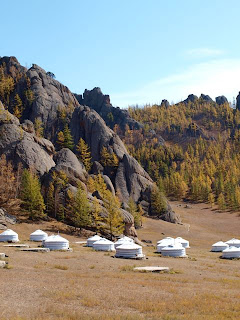Next to Siberia (coincidentally our next destination), there aren't any other places as remote from the Western consciousness than Mongolia. Other than Genghis Khan and the Mongols, there isn't too much else notable about this place, or at least notable enough to merit a mention in world history class. Which is why being here has been fascinating- it's as if every time we step outside or talk to a local, we are learning something radical and new about the country, its history, and its people.
Stepping outside without proper preparation today, however, could imperil your health. Right now, the snow is falling heavily, and although its "only" 30 degrees, it feels considerably colder. Could that be because it's still officially summer for another two days, or because just yesterday it was 70 and sunny enough to give me a nice tan? Lest one think that this is a freak event, a very short story: after being picked up from the train station by the hostel owner, we asked her, trying to make small talk, when winter started. "Oh, next week," was her nonchalant response. If you think that Mongolia's climate is anything less than extreme, think again.
Mongolia has been a hard place to get my head around. There are few paved roads outside the capital, Ulaan Baatar; instead, trucks rumble across the hard-packed steppe, their paths visible from miles away due to the plumes of dust they kick up. In UB, the former nomads who make up a majority of the city's population still live in gers, or traditional tents, which are made slightly more permanent by the addition of fencing around them. The seeming isolation of the city from the rest of the world is belied by the Korean shabu-shabu restaurants, Mexican food joints, and German bakeries that line the streets. The Mongolian National Symphony (which we saw perform, along with award-winning throat singers, dancers, and musicians at an absolutely fantastic "Cultural Show", where the $9 tickets were a guilt-inducing bargain) plays the overture from the Barber of Seville, but using only traditional Mongolian instruments. But it's these exact dichotomies, Mongolia's inability to decide how far it wants to enter the developed world, that makes it a captivating place to visit.
The other, more readily-apparent draw for visitors is the extraordinary natural beauty of countryside. On the steppes, this beauty lies in their never-ending, barren expanse. Flat grassy plains lead to rolling brown hills on the horizon, with only small herds of animals breaking up the monotony of the landscape. The sky is indescribably vast and blue; by a totally subjective comparison, the Montana sky looks like it's being viewed through a pinhole.
Mountains and rock formations occasionally break up the steppes, and it was at the base of one outcropping that we spent two nights at a remote ger encampment two hours outside of UB. We did the typical things that tourists do in Mongolia- ride horses, take short hikes, absorbing in the scenery. We also got a chance to see some other traditional Mongolian activities, thanks to the tourist camp next to ours and the 200 Germans who were bussed in for the day. Steins of beer in hand and cameras strung around their necks, we were presented with an exhibition in traditional archery, wrestling, and horse racing. The whole scene was a little bizarre, actually- the Germans were allowed to try their hand at the archery, which inevitably led to arrows (thankfully rubber-tipped) flying into crowds of people; the wrestlers posed for photos after the wresting exhibition, which turned into something resembling a paparazzi rush as the crowd shoved cameras into their faces; and trinket sellers descended on the camp, materializing out of nowhere.
As a final note, the more time I spend here, the more I'm amazed at how much the Mongols contributed to world civilization. Paper money? The Mongols. The concept of diplomatic immunity? The Mongols. The violin bow? The Mongols. Creating the trade routes that bridged the East and the West and led to a flowering of trade and thought that brought about the beginning of the Renaissance? Goes without saying. For a basic overview, read "Genghis Khan", by Jack Weatherford. For a deeper understanding, come to Mongolia.

